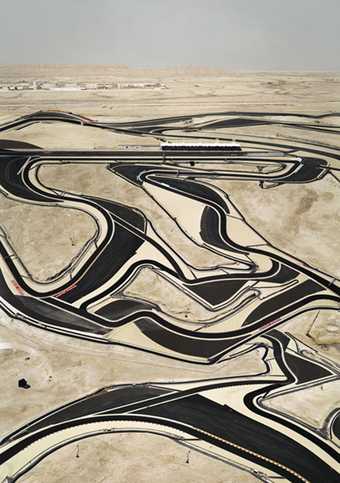Andreas Gursky was born in Leipzig, East Germany, in 1955. His father and grandfather were both photographers. He trained in Essen and then in Düsseldorf, where he studied with Bernd Becher.
Becher, together with his wife Hilla, developed a systematic approach to the photographic subject – in their case serial studies of industrial architecture – which was enormously influential on a whole generation of artists using photography, both in Germany and elsewhere.
Gursky uses a medium format camera to photograph his subjects. This gives him a 4 x 5 inch negative from which he produces his crisply detailed colour prints. He has said that he carries images around with him, ready-made, in his head. Sometimes he recognises these images in the outside world and photographs them. Other times he instinctively photographs scenes and only later, in the darkroom, recognises them as worthy of becoming art works. Often he looks for a long time, visiting and revisiting a scene before taking any pictures at all. Sometimes he takes many shots, but sometimes one is enough. He aims to give back to the viewer something which they may already have seen – he uses computers rarely, and then only to recreate something seen rather than to create something unseeable. In the same way, though he may manipulate the colour in his images, upsetting the 'normal' tonal balance of the image, this is in order primarily to intensify the viewer's encounter with the photographed scene. Gursky's works are difficult to reproduce – they function best as objects. They have a spatial presence in the gallery, drawing the viewer in to recognise and share their once real, now fictive spaces.
PTT, Rotterdam, an electronic postal sorting office, is a picture of order and control. The image is relentlessly horizontal, the format of the photograph itself reinforced by the long, low lines of the ceiling ducting and the machinery and furniture which fill the frame. A man sits to the far left of the main sorting machine, processing information. His activity mirrors our own, as we scan the image from left to right and back again, sorting the visual clues, working out what exactly it is that we are seeing. As we do this, it becomes clear that our gaze is being directed: the photograph is in fact two photographs, one of the left, one of the right, joined together on a computer. The process is clearest in the ceiling. The vertical, hanging baffles form a chevron shape in the centre, and instead of one, central vanishing point there are two.
This image, like all Gursky's images, draws the viewer into a relationship based on complicity. It is trying to show us how we see. Having found an image, Gursky captures it, using technology where appropriate to bring it into the gallery. The image is not of anything unusual, but of a scene readily available in the natural or man-made world. It is scaled to, and ordered by, the presence (or implied presence) of the human figure. It suggests that the natural world is man-made, and remade, every time we look at it.


